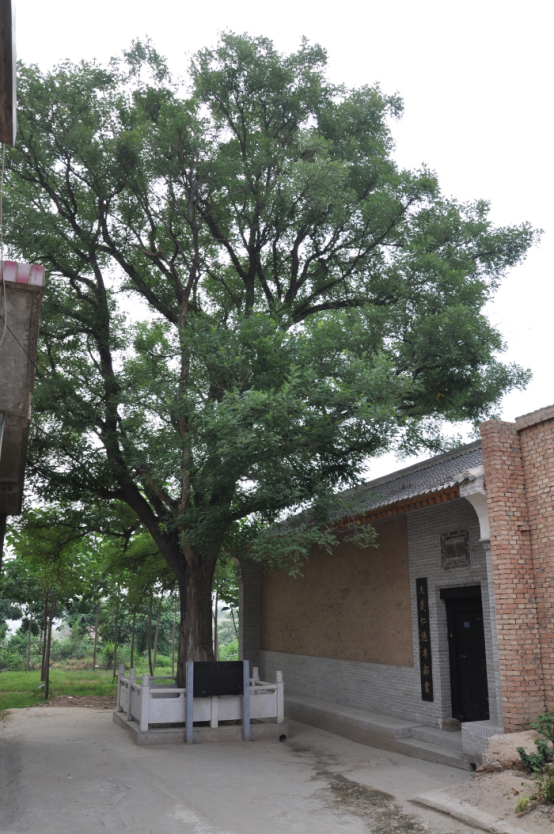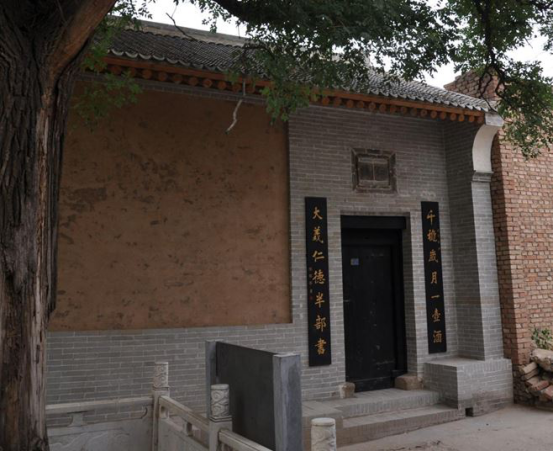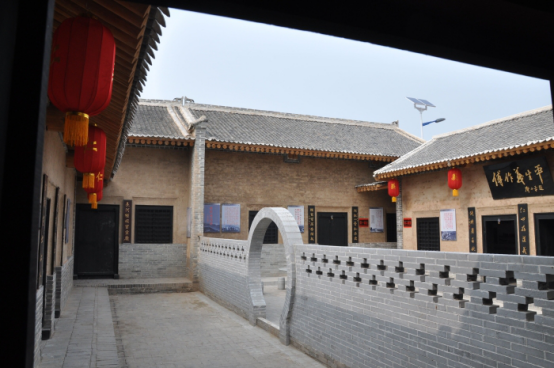Fu Zuoyi’s former residence, the only national AA-level tourist attraction in Linyi county, was entitled “the educational base of the history of the Communist Party of China (CPC) in Shanxi province” by the administration office of CPC’s history committee. It is located in Anchang villiage alongside the Yellow River. The village, with ravines and gullies and its important pass, is the military stronghold historically.
Fu Zuoyi was born on June, 27, 1895 (intercalary month May, 5 in Lunar calender) in Anchang Village, Sunji Town, Linyi County (originally Ronghe County). He was a big fan of Martial Arts at his youth. He then was enrolled in Shanxi Taiyuan Army Primary School, Beijing Qinghe Army Secondary School, and Hebei Baoding Military Officer’s School. He used to take part in Shanxi 1911 Revolution. During the Northern Expedition War, he stood fast at Zhuozhou. He made outstanding battle achievement in the War of Resistance against Japanese. He led Beiping Peaceful Uprising in the War of Liberation. After the founding of People's Republic of China, he was appointed as vice-chairman of Chinese People’s Political Consultative Conference (CPPCC), the vice-chairman of National Defence Commission and the minister of the Ministry of Water Resources (MWR) and other positions of leadership. He contributed remarkably to Chinese revolution and construction. Mao Zedong, Zhou Enlai and De Xiaoping thought very highly of him. He died on April 19, 1974 at his 79 years old.
There are two houses originally in Fu Zuoyi’s former residence, one of which was built by Fu Zuoyi’s grandfather Fu Wending over 170 years ago and stays just the same after three-time refurbishment. And the other three new houses, established by his father Fu Qingtai in 1990 covering an area of 1.2 mu (a unit of area, 1 mu≈667㎡), contain 48 rooms achieved with 20 years successively. Japanese invaded the village in the winter of 1938. Japanese invaders wrecked the three new houses for revenging Fu Zuoyi’s action in Changcheng and Suiyuan Battles. They carried the timber tore down from the houses for building blockhouse and burned useless stuff. Protected by local folks, Fu Zuoyi’s former residence where he was born survived and preserved.
Since 2012, based on the principle of “refurbishing the old as the original, maintaining its proper appearance ”, Linyi County Party committee and government started to protect and refurbish Fu Zuoyi’s former residence and his cousin’s house where he was accommodated when he went back hometown in April, 1957. The government developed the related scenic spots such as “Benevolence and Righteousness Lane”, “Bronze-casting Statue”, “Serving-the-country Tree”, “Fu’s Family Homestead” and “Lotus Pond” and established “Fu Zuoyi’s life story exhibition”, which has been open to all visitors presently. Fu Zuoyi’s former residence was entitled “the educational base of the history of the Communist Party of China (CPC) in Shanxi province” by the administration office of CPC’s history committee.
Fu Zuoyi lived a common but amazing life. He sticks to his belief while facing troubles and keep together in the face of adversity. With his words and actions and his achievement and accomplishment, it produces the content of the Red Revolution for patriotic education and also the valuable treasure of the education of CPC’s history. In recent years, the provincial, municipal and prefectural relevant departments successively award Fu Zuoyi’s former residence and “Fu Zuoyi’s life story exhibition” the educational base for CPC’s history, patriotism, the united front work and virtuous and filial culture.

Benevolence and Righteousness Lane
The lane in front of Fu Zuoyi’s former residence, used to be named “Benevolence and Righteousness Lane”, was hardly to trace the time when it was established. But it is said that the lane was built in accordance with the traditional Confucian culture and moral standards of Fu’s family. The ten brothers in Fu Zuoyi’s family were given names as the order of “benevolence, righteousness, propriety, wisdom, faith, gentleness, goodness, courtesy, modesty and generosity”. The memorial gate established at that time had been collapsed because of long years out of repair. The gate has been reconstructed at the original site in order to inherit the traditional Confucian culture of “Benevolence and Righteousness”.

Lotus Pond
Originally, there was an earthy pool called “Dachi (big pool)” behind Fu Zuoyi’s former residence. It is 48.8 meters long, 22.8 meters wide and three meters deep covering an area of 1112.64㎡. The establish time is hardly to be traced. The pool had been used to save rain water from the laneway in the village for villagers’ laundry, watering the vegetables and offering drinking water for livestock. It was made of earth and full of water throughout the year, so that lotuses were planted in the shallow part of the pool which was surrounded by willows. Fu Zuoyi played a lot in the pool for swimming and fishing with his friends in their childhood. He read books, took a walk and exercised alone under the shadow of trees at the pool side. The cleanliness of water and purity of lotus root had shaped his hardworking and thrifty and honesty. The pool was long neglected and in bad repair damaged and flatted. In honor of his noble quality as a General, the earthy pool has been rebuilt with a “lotus-root” shape at the original spot in December, 2013, The length of the pool is ten meters less than the former one, and the width is four meters less covering an area of 529.44㎡ and is now named “Lotus Pond”.

Bronze-casting Statue
The bronze-casting statue of Fu Zuoyi is designed by youth sculptor Ren Yanming from Academy of Fine Arts in Nanjing University and manufactured by Shanxi Yuda Group. It is 1895 centimeter high with the width of the front base up to 62.7 centimeter, which means that he was born on June 27, 1895. The bottom base is 23 centimeters high which means that he served as the minister of the Ministry of Water Resources as long as twenty-three years. The upper base is 13 centimeters high which means he fought the Chinese People’s War of Resistance against Japanese Aggression for thirteen years. The flank base is 57.4 centimeters wide which means he went back hometown in April, (19)57. The statue is 74.4 centimeters high which means he passed away in April, (19)74. The middle base is 79 centimeters high which means that he died at the age of seventy-nine.

Serving-the-country Tree
Fu Zuoyi planted a tree at his young age symbolizing that he was determined to be a useful person and dedicated himself to serve the country faithfully. The tree, tended by him and his relatives, presenting wide spreading branches and luxuriant foliage. In the winter of 1938, Japanese invaded the village. They insanely burned the village for revenging Fu Zuoyi’s action in Changcheng and Suiyuan Battles. Unfortunately, the tree became “practicing killings with kinves” and “target of killing a living person” by Japanese invaders in the village. The trunk of the tree appears as hundreds of knife wounds. Fifty years later, the tree doesn’t withered or die but to be taller and stronger than before. Especially, the scar on the trunk of the tree and the flowing sap witness the aggression of Japanese invaders against China and the trail of tears of innocent victims. By bearing in mind the miserable history, villagers renamed the “serving-the-country Tree” into “the War of Resistance Tree”. In April, 1957, the General Fu returned hometown. Standing under the tree, he highly evaluated villagers’ fearless anti-Japanese spirit and felt guilty of the innocent victims killed by Japanese soldiers. He lived in the west of his cousin’s house to express his belated nostalgia.

The Old Houses
Fu Zuowei, as Fu Zuoyi’s cousin, held a house containing a triangle courtyard with nine rooms. The time of construction was hardly to be traced, but local folks supposed it was established at the same age with Fu’s family house based on its architecture materials and patterns. The old house had been refurbished several times. It’s recorded that three rooms in the east were moved to the west in 1968 and also three rooms (including the gatehouse) in the south and three old rooms in the west had been refurbished in 1984. According to the principle of “refurbishing the old as the original, maintaining its proper appearance ”, all nine rooms were refurbished in 2012. The reconstructive three rooms in the west which used to be in the east had been removed back to the east. In April, 1957, General Fu rejected politely a lot of entertaining from local officers and was determined to be accommodated at his cousin’s house.

Fu’s Family Homestead
It was established by Fu Zuoyi’s grandfather Fu Wending 170 years ago. It is 24.3 meters long from the south to the north and 6.1 meters wide from the east to the west. It covers an area of 148.4㎡. It is the ordinary peasant’s house with the architecture style of the late Qing Dynasty. Fu Zuoyi lived his childhood here with his grandfather, grandmother, father and mother. The northern rooms collapsed in 1958. The western rooms were refurbished in April, 1961. The Southern rooms collapsed in 1975. The western rooms were refurbished again in July, 2002. According to the principle of “refurbishing the old as the original, maintaining its proper appearance ”, the western rooms were refurbished for third time and the old northern rooms and southern rooms were reconstructed in May, 2012.

Fu Zuoyi’s life story exhibition
To exhibit General Fu’s great achievement and pass his thoughts and spirit to next generations, an exhibition room, under the principle of “the same material, the same pattern” proposed in May, 2013, was constructed as telling General Fu’s life stories. The exhibition room covering an area of 218.7㎡, with three new rooms in the north, three new rooms in the east, three new rooms in the south, was built at the east side of Fu’s old houses. The courtyard is separated into two parts by the wall, with the west of which is the original old houses and the east of which is the new exhibition room.
Developing and constructing Fu Zuoyi’s former residence is one priority project for improving the popularity through culture of Linyi County. The County Party committee and government has been putting the project into practice as one of the ten scenic spots of “the Yellow River local custom tourism belt ”. We firmly believe, under the proper leadership of the County Party committee and government, that a good-quality tour of revolution which respecting the history, reflecting the truth, embodying the spirit and spreading thoughts and ideas would be shown in the coming years.
Address: Fu Zuoyi’s Former Residence, Anchang Village, Sunji Town, Linyi County.
Contact us:Fu Chuangjie 13934373954 Cui Lijuan 13735957816
Routes: Self-driving tour
Hebao High Speed way---Sunji Town---Anchang Village---Fu Zuoyi’s Former Residence
Wanrong Houtuci Temple---Anchang Village---Fu Zuoyi’s Former Residence

